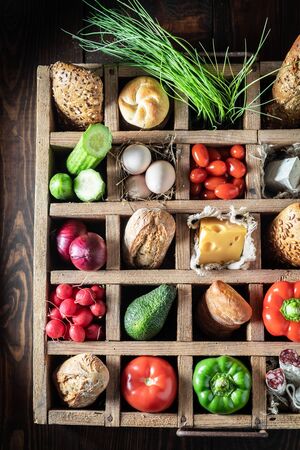Understanding Common Toxins in British Foods
When it comes to maintaining a balanced lifestyle, its crucial to be aware of the hidden toxins that may be lurking in your daily British diet. The average grocery shop or local chippy may seem harmless, but many popular foods contain substances that could impact your long-term health. Among the most prevalent culprits are processed foods, which often contain high levels of salt, sugar, and unhealthy fats. But thats not all—these foods frequently feature additives and preservatives designed to extend shelf life or enhance flavour, such as E-numbers and artificial sweeteners.
Pesticides are another concern, particularly in conventionally grown fruit and veg you might pick up at the supermarket or greengrocer. While regulations exist, residues can remain on produce and make their way into your meals. Even seemingly wholesome staples like bread, cereal, and ready meals can harbour hidden nasties—think emulsifiers, colourings, and chemical flavour enhancers. Fast food favourites like fish and chips or chicken tikka masala from your local takeaway may also be cooked with oils containing trans fats or subjected to high-heat processes that generate acrylamides, both linked to adverse health effects.
By recognising these sources of toxins within typical British groceries and takeaways, you lay the foundation for making mindful choices about what ends up on your plate. In the following sections, we’ll explore how to spot these ingredients and share practical steps for reducing your exposure while still enjoying the flavours of British cuisine.
2. Spotting Hidden Culprits in Everyday Meals
Many of the foods gracing British tables—from a humble bowl of breakfast cereal to a cheeky packet of crisps or a convenient ready meal—may contain ingredients best kept at arm’s length. To maintain balance and well-being, it’s crucial to become savvy about what’s really in your food. The first step is learning how to read British food labels with a discerning eye.
Decoding British Food Labels
The front of the packaging might be emblazoned with claims like “low fat” or “wholegrain,” but the back tells the real story. In the UK, ingredients are listed by weight, so those appearing first make up most of the product. Pay close attention to additives, E-numbers, and unfamiliar chemical names—these could be preservatives, colourings, or sweeteners that may not align with your health goals.
Common Hidden Toxins to Watch For
| Food Type | Potential Hidden Toxins | What to Look For on the Label |
|---|---|---|
| Breakfast Cereals | Sugar, artificial sweeteners, preservatives | Sucrose, glucose syrup, aspartame (E951), BHT (E321) |
| Crisps | Artificial flavourings, excessive salt, acrylamide | Monosodium glutamate (MSG), E621, “flavour enhancer”, high sodium content |
| Ready Meals | Trans fats, emulsifiers, colourants | Partially hydrogenated oils, E471, E102 (tartrazine), E110 (sunset yellow) |
A Handy Tip for Busy Shoppers
If you’re dashing through Sainsbury’s or Tesco on a weekday evening, try using the traffic light system on packaging—a uniquely British labelling scheme. Red means high levels of fat, sugar or salt; amber is moderate; green is low. Opting for more greens helps keep your daily toxin intake in check while enjoying your favourite local foods.

3. Decoding British Food Labelling Laws
When it comes to steering clear of hidden toxins in your British diet, understanding the intricacies of UK food labelling is essential. The UK has robust regulations that require manufacturers to disclose key information on packaging, but knowing how to interpret these labels can make all the difference to your health and wellbeing. Familiarise yourself with terms such as “additives”, “preservatives”, and “E numbers” – many of which may indicate the presence of artificial substances you’d rather avoid. Pay attention to allergen declarations, ingredient lists ordered by quantity, and any claims like “organic” or “free from”. These aren’t just marketing buzzwords; they’re regulated terms with specific meanings under British law. Make a habit of scanning labels for red flags like excessive sugar, salt, saturated fats, or unfamiliar chemical names. By equipping yourself with this knowledge, you’ll be empowered to make informed choices on your next shop at Tesco or Sainsbury’s, opting for products that truly support a balanced lifestyle rather than undermine it with hidden nasties.
4. Swapping for Safer British Alternatives
If you’re aiming to cut out hidden toxins from your British diet, the good news is you don’t have to abandon the flavours and dishes you love. Instead, it’s about making smart swaps—choosing safer, locally-sourced alternatives that keep traditional tastes alive while supporting your well-being.
Why Choose Local?
Many mass-produced foods contain additives, preservatives, and pesticides that can linger in your meals. By opting for local produce and products with fewer food miles, you naturally reduce your exposure to these substances. Plus, supporting British farmers keeps the countryside thriving.
Practical Swaps for Everyday Staples
| Traditional Ingredient | Typical Concern | Safer British Alternative |
|---|---|---|
| White supermarket bread | Additives, bleaching agents | Sourdough or wholemeal loaf from a local bakery |
| Bottled salad dressings | Artificial flavours & preservatives | Homemade vinaigrette with British rapeseed oil |
| Processed sausages | Nitrites and fillers | Butcher’s handmade sausages with traceable ingredients |
| Imported tinned fish | BPA-lined cans, heavy metals | Fresh Cornish mackerel or sardines from UK fishmongers |
| Ready meals | Hidden sugars, salt, E-numbers | Batch-cooked homemade pies or stews using seasonal veg |
Keeping British Flavours Alive
You don’t need to miss out on iconic British tastes. For instance, swap mass-market cheddar for an unpasteurised farmhouse variety, or try baking scones with organic British flour. When craving something sweet, choose local honey over imported syrups.
Tips for Shopping Local and Safe:
- Visit farmers’ markets or farm shops for fresh produce and meat.
- Look for “Red Tractor” or “Soil Association” certified labels for extra assurance.
- If buying packaged goods, read ingredient lists carefully—less is more.
A Little Effort Goes a Long Way
Making these swaps might take a bit of planning at first, but soon it becomes second nature. Not only will you be reducing your intake of hidden toxins, but you’ll also rediscover the true taste of Britain—fresh, vibrant, and deeply satisfying.
5. Balancing Your Plate for Better Wellbeing
Finding equilibrium in your daily meals is a cornerstone of reducing hidden toxins and supporting overall health. To start, incorporate seasonal British produce whenever possible. Not only does this support local farmers and reduce food miles, but it also means you’re eating fruits and veg at their nutritional peak—think tender spring asparagus, summer berries, or hearty root vegetables through winter. Eating with the seasons can naturally diversify your diet and limit reliance on highly processed foods that often carry unwanted additives.
Choosing Organic Where It Matters
If budget allows, select organic options for items most prone to pesticide residue, such as apples, spinach, or potatoes. Organic certification in the UK ensures stricter guidelines for chemical use and animal welfare, offering some peace of mind when it comes to hidden toxins. Even switching a few staples—like organic milk or eggs—can make a meaningful difference over time.
Mindful Practices for Every Meal
Beyond what’s on your plate, how you approach eating is just as important. Practice mindful eating: slow down, savour each bite, and listen to your body’s hunger cues. This not only enhances digestion but can help you notice how certain foods make you feel, flagging potential sensitivities or reactions that might have gone unnoticed.
Cultivating a Toxin-Aware Lifestyle
Balancing your British diet isn’t about deprivation—it’s about making small, sustainable swaps that promote wellbeing. Swap out sugary packaged snacks for oatcakes topped with local cheese or sliced apples. Enjoy a cuppa with a splash of organic milk rather than reaching for fizzy drinks full of artificial sweeteners. With each thoughtful choice, you’ll be taking another step towards a toxin-aware and truly balanced way of living.
6. Long-term Strategies for Living Toxin-Free in the UK
Creating lasting change in your diet and overall wellness often comes down to the routines, traditions, and community connections you build around food. In the UK, where food culture is deeply woven into daily life and social gatherings, embracing mindful habits can make a significant difference in minimising your exposure to hidden dietary toxins.
Embrace Healthy Routines
Start by establishing simple, sustainable routines such as planning weekly meals with seasonal British produce, reading food labels before purchasing, and cooking more from scratch using whole ingredients. Making a habit of shopping at local farmers markets not only supports local growers but also reduces your reliance on processed foods that may contain additives or preservatives.
Revive Family Traditions
Many classic British family recipes are rooted in wholesome ingredients and slow-cooked methods. Bring back these nourishing traditions by involving your family in meal preparation or hosting regular Sunday roasts with plenty of vegetables. Passing down these healthy habits helps younger generations develop a palate for natural flavours and understand the importance of avoiding unnecessary chemicals in food.
Connect With Community Resources
The UK offers a range of community initiatives focused on healthy eating and toxin reduction. Look out for local allotment schemes, cooking classes, or cooperative veg box deliveries that encourage diverse, fresh diets. Many NHS trusts also provide nutritional advice and support for those wanting to make positive lifestyle changes. By tapping into these resources, you gain both knowledge and social motivation to stay toxin-aware.
Ultimately, living toxin-free is about making conscious choices every day—choosing fresh over processed, supporting local over imported, and fostering connections that reinforce your commitment to wellbeing. As you integrate these practices into your British lifestyle, you’ll find that reducing dietary toxins becomes second nature and leads to a healthier, more balanced life for you and your loved ones.


